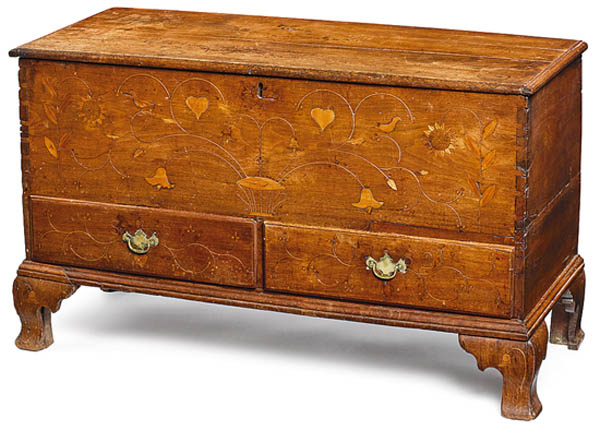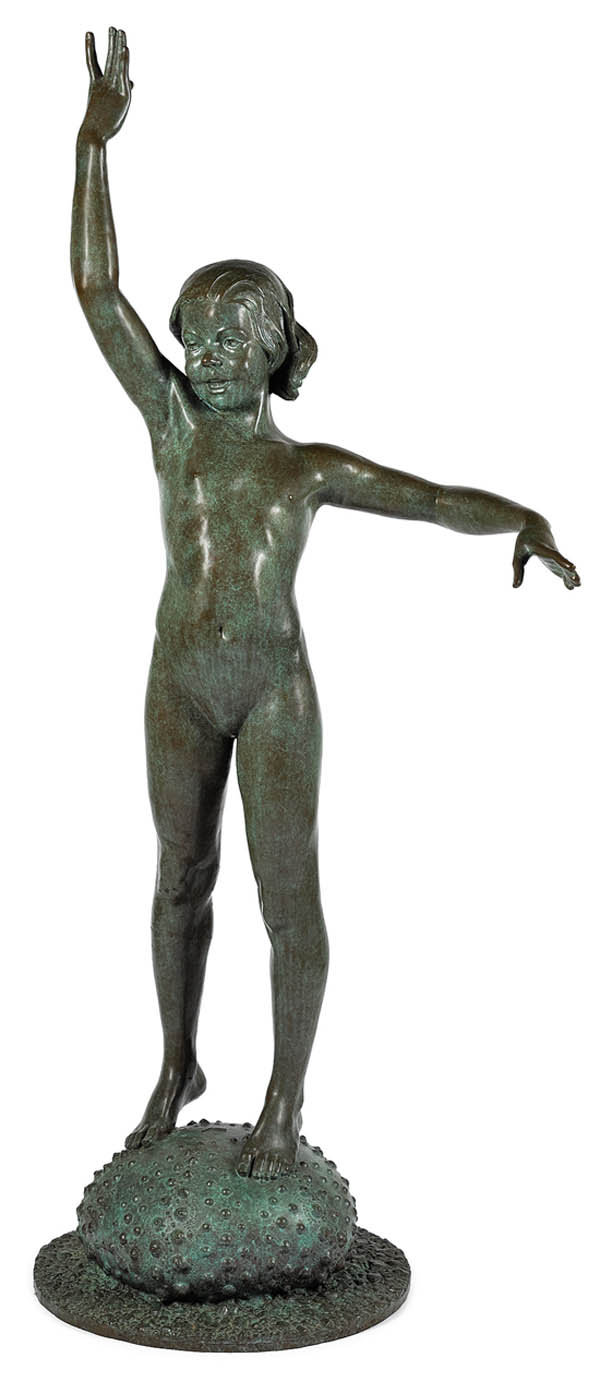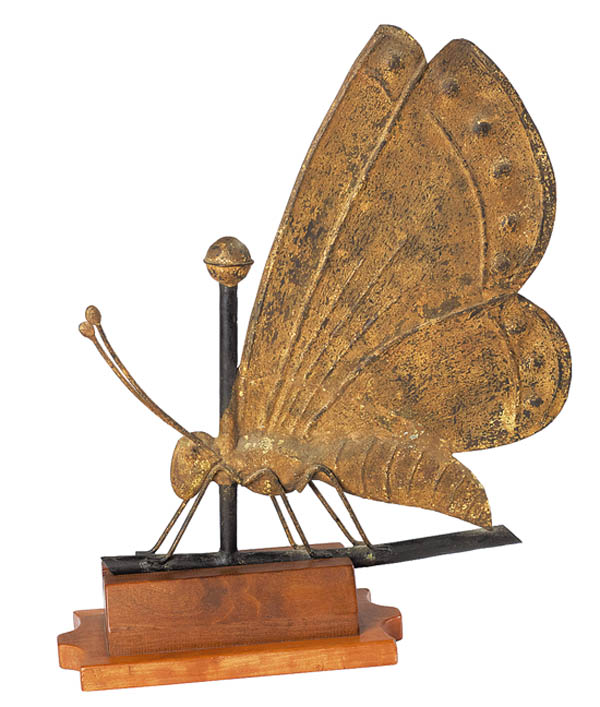The Moderns Were Not Just Mousing Around
Pook & Pook’s Two-Day Sale Grosses 3.5 Million
By Cynthia Beech Lawrence - November 05, 2021
The Pook & Pook Americana and International Sale sold across two live sales on Sept. 30 and Oct. 1 totaled $3,538,163. The sell-through rate was 98.6 percent, and 5,614 bidders participated from 39 countries and five continents, bidding online, by telephone, and in person. For many of the standout lots, as many as seven telephone lines were engaged in bidding. It was 20th century American Modern Art that took center stage, providing the four top selling works. The top selling highlight was Andy Warhols (1928-87) Mickey Mouse, from the Myths series, 1981, screenprint numbered 147/200. Myths is a series of 10 images of 20th century American pop culture, celebrity icons that Warhol believed replaced the Gods and heroes of previous generations. Presenting a new American mythology, the Myths series evoked 1950s childhood and nostalgia for a golden past. Mickey Mouse, dusted with diamonds, is presented as a celebrity, a cultural icon, an all-American and corporate symbol. He is slick, packaged, and ready to sell, estimated at $80-$120,000, the limited number screenprint sold for $196,800. Harriet Whitney Frishmuths (1880-1980) bronze fountain Crest of the Wave, 1926, one of the artists most famous works, came in with a solid result at $147,600. The 19th Amendment, ratified in 1920, guaranteed all American women the right to vote. After decades of struggle, a new era was born. Frishmuths youthful and strong sculpture captured the spirit and energy of the times. Another modernist work, the bronze Mans Head, ca. 1906-07, by Elie Nadelman (1882-1946), estimated $40,000-$60,000, realized $116,850. An early work of the sculptor, it approaches geometrical abstraction, with the long opposing curves of the face meeting at the point of the chin and suggesting volume and harmony. Mans Head is a product of Nadelmans study of ancient sculpture and pursuit of classical economy, which resulted in a modern style uniquely his own. Paul Manships (1885-1966) bronze The Moods of Time: Morning, Day, Evening, and Night, cast ca. 1992, numbered 5/12, estimated $15,000-$25,000, was another top Modern lot. The streamlined Art Deco style of Paul Manship looked ahead to the future, while his subject matter reached back into the archaic past. In a world of flux and uncertainty, Manships sculpture offered reassurance, mediation, and synthesis, according to Susan Rather from Archaism, Modernism, and the Art of Paul Manship. Time was fleeting as the bidding rose and the bronzes crossed the block at $98,400. The bronze Bird (with an Attitude), 1952, 5/6, by Dame Elisabeth Frink (1930-93), estimated $12,000-$18,000, sold for $36,900. Early American art also sold well. An oil-on-canvas by the famous Charles Willson Peale (1741-1827), a hauntingly lovely portrait of Sarah Benezet Bartow (1746-1818) of Philadelphia, signed and dated 1772, and estimated at $10,000-$15,000, sold for $36,900. American furniture had a strong showing. The category was full of quality pieces. A lifelong collection of American clocks and furniture, the estate of Charles West Wilson, of Red Lion, Pa., provided many of the top selling lots. A rare New York Federal mahogany musical tall case clock, ca. 1790, with eight-day works signed Effingham Embree New York, estimated at $20,000-$30,000, clocked in at $92,250. A Philadelphia Chippendale walnut tall case clock, ca. 1775, with face inscribed Willm Huston Philadelphia, estimated at $8,000-$12,000, brought $20,910. A Massachusetts mahogany lighthouse clock, ca. 1820, attributed to Simon Willard, estimated $4,000-$7,000, sold for $19,680. From the Wilson collection was the Taylor Family Queen Anne mahogany easy chair, made in Philadelphia, ca. 1760, estimated $20,000-$30,000, going just over estimate at $31,980. A Delaware Valley Queen Anne tiger maple high chest, ca. 1765, originally owned by Continental Congress member Col. Charles Pettit, estimated at $8,000-$12,000, sold for $17,220. Telephone, internet, and floor bidders battled for a Federal mahogany marble top end table, ca. 1820, possessing all the attributes of a rare Duncan Phyfe kettle stand, which realized $86,100. An important Massachusetts Federal mahogany three-part secretary desk, ca. 1805, attributed to the shop of John and Thomas Seymour, a highly sophisticated desk featuring an array of satinwood panels and inlaid edges, possessed an interesting provenance. Purportedly found in Ireland after having been brought there in the early 19th century by the Galloway family, its estimate was $10,000-$15,000, and it went for $41,820. Americana treasures abounded: weathervanes, frakturs, quilts, and trade signs, to name a few. A miniature Pennsylvania painted pine blanket chest, ca. 1810, with shell decoration on a green ground and intricate pin stripes, stenciled Miss M. A. Smith, estimated at $5,000-$7,000, sold for $15,990. A Lancaster County painted Weber miniature dressing box, decorated with large flowers on the top and sides, the front with a house flanked by trees, all on a vibrant yellow ground, came in over its $8,000-$12,000 estimate at $17,220. A large Pennsylvania watercolor scherenschnitte valentine, dated 1834, was a sight to behold. Intricately executed with floral vines, hearts, and running stags, it sold within its estimate at $12,300. And a Chester County walnut line and berry spice chest, ca. 1760, and possibly the only known example with a decorated top, sold within its estimate at $12,300. A scarce Francis Richardson Jr. Philadelphia silver porringer, ca. 1740, estimated at $3,000-$5,000, sold for $10,455, and a Georg Jensen sterling silver pitcher, by Henning Koppel, estimated at $5,000-$7,000, brought $15,990. An important Boston, Mass., needlework, ca. 1780, depicting two couples in front of a Georgian brick home with a young woman, leaping dog, and African American servant pouring glasses of wine, was the top textile lot. An early typed note verso states that the needlework descended in the family of Revolutionary War Gen. Christian Febiger (1749-96). Estimated at $20,000-$30,000, it sold for $34,440. Closing the sale as usual were a selection of carpets. An early 20th century Oushak, estimate $3,000-$5,000, sold for $14,760. A fine Serapi carpet, ca. 1910, estimate $4,000-$6,000, realized $15,990. Join Pook & Pook later this fall for more auctions, including Native American Indian, Coins and Jewelry, Decorative Arts, and Antique Toys and Board Games. For additional information, call 610-269-4040.







SHARE
PRINT